Question
mainLab2.hs: main=do --Problem 1 putStrLn -Problem 1- putStrLn Input: 18, 42 putStr Output: print(gcdMine 18 42) putStrLn gcdCheck... check print(gcdCheck 111 259) print(gcdCheck 2945
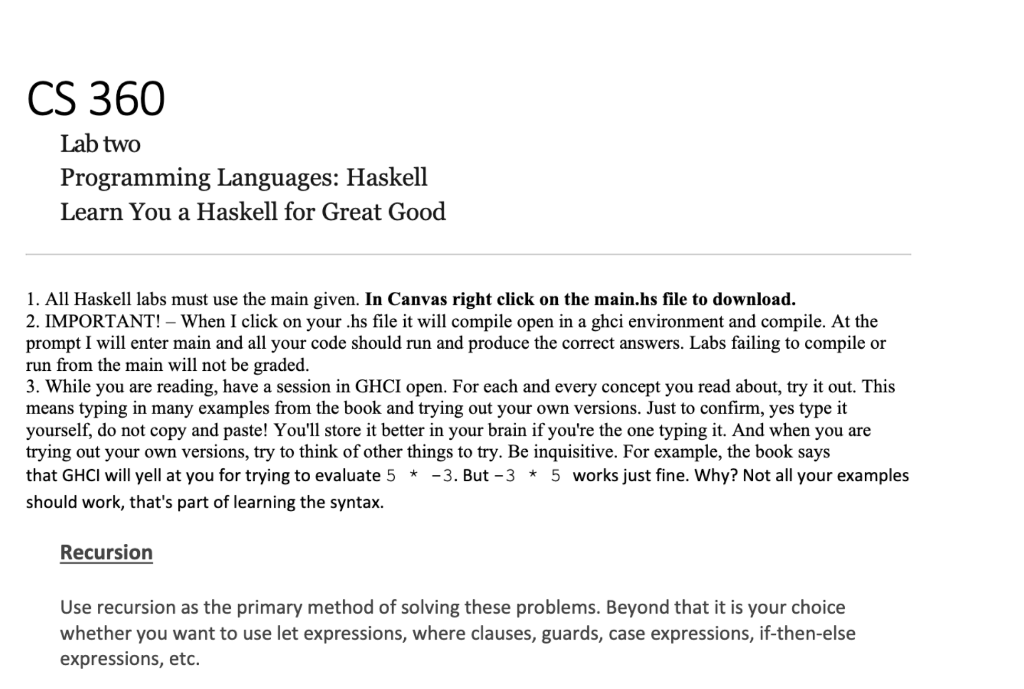

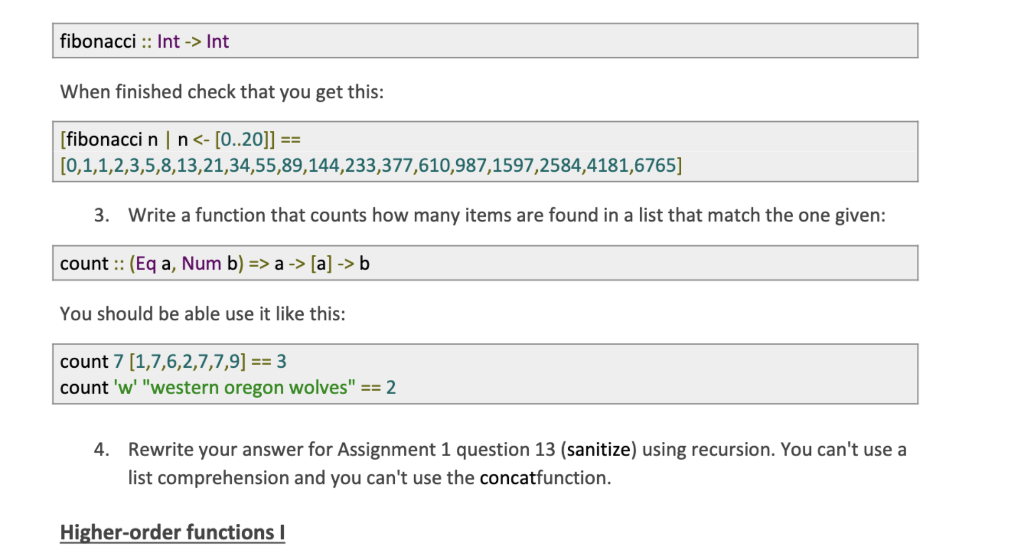
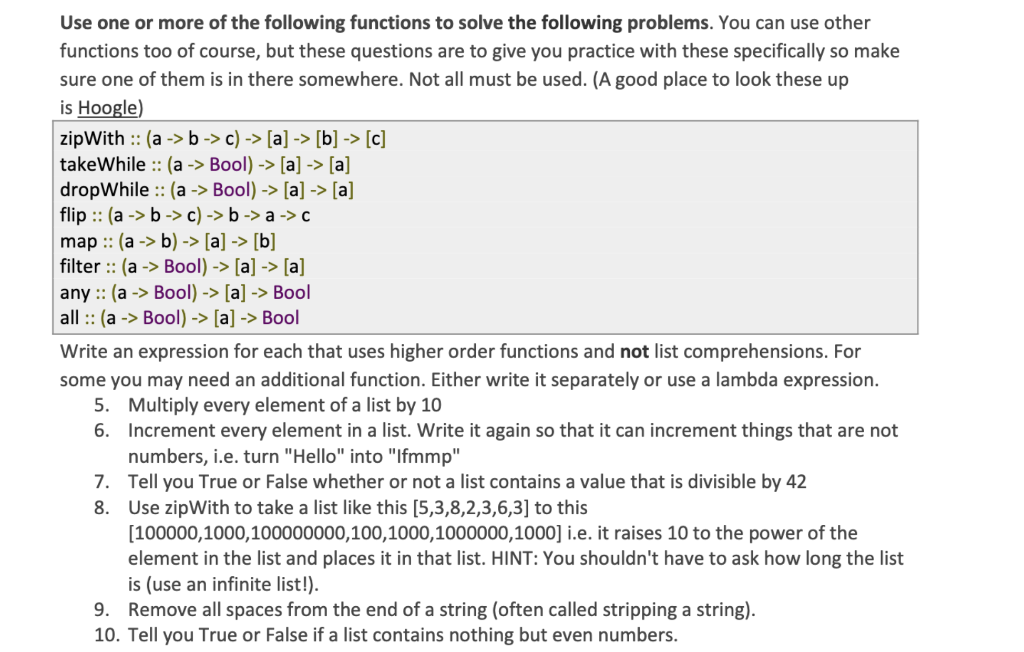
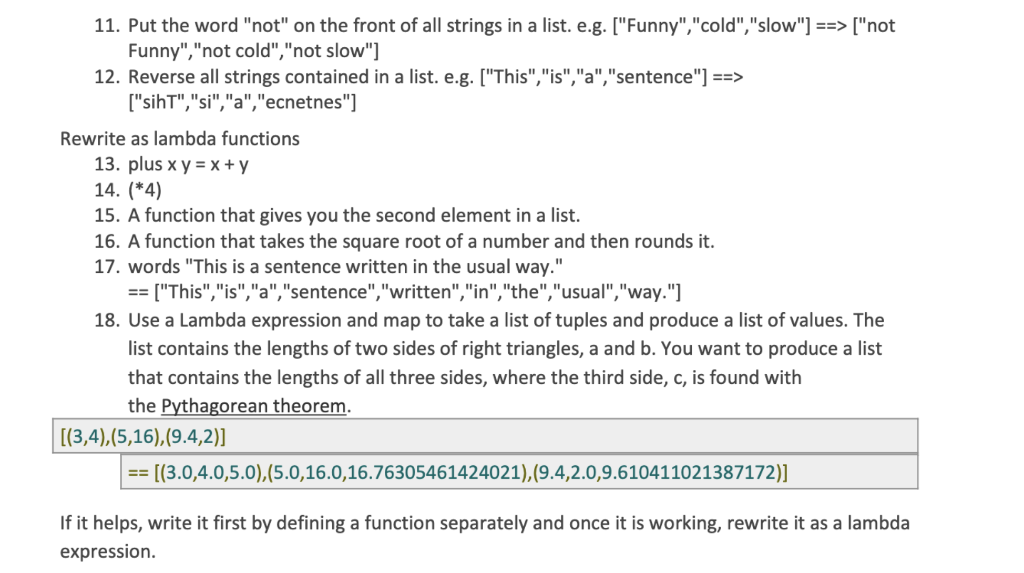

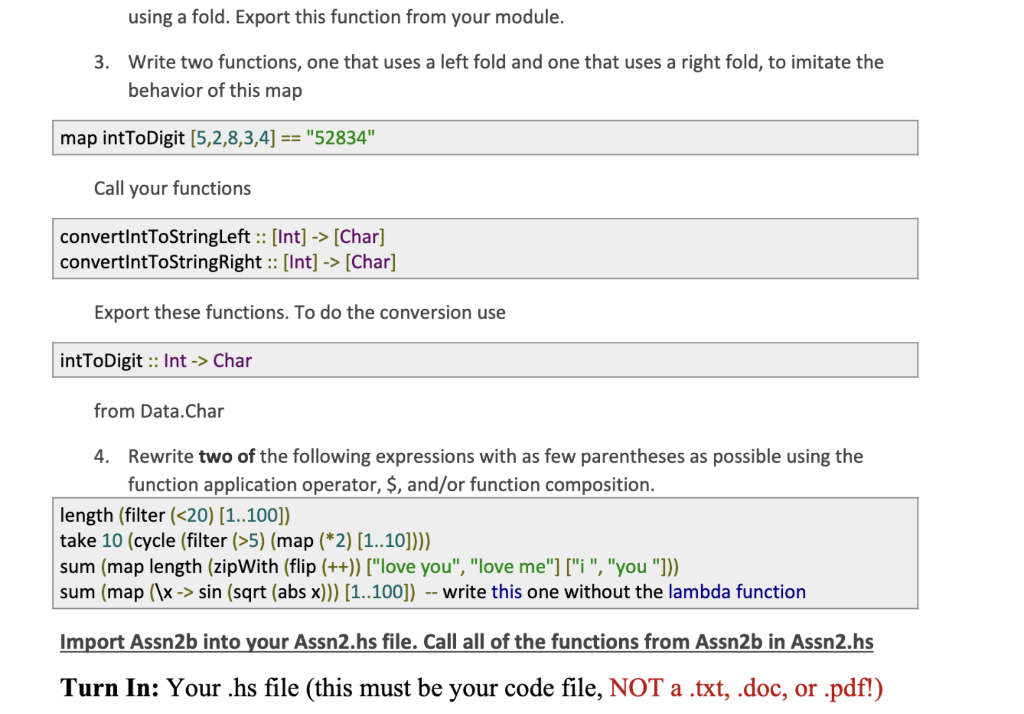
mainLab2.hs:
main=do --Problem 1 putStrLn "-Problem 1-" putStrLn "Input: 18, 42" putStr "Output: " print(gcdMine 18 42) putStrLn "gcdCheck... check" print(gcdCheck 111 259) print(gcdCheck 2945 123042) print(gcdCheck (2*5*7)(7*23)) putStrLn"" --Problem 2 putStrLn "-Problem 2-" putStrLn "Input: 20" putStr "Output: " print(fibSeq 20) putStrLn "" --Problem 3 putStrLn "-Problem 3-" putStrLn "Input1: 7 [1,7,6,2,7,7,9]" putStr "Output1: " print(count 7 [1,7,6,2,7,7,9]) putStrLn "Input2: 'w' \"western oregon wolves\"" putStr "Output2: " print(count 'w' "western oregon wolves") putStrLn "" --Problem 4 putStrLn "-Problem 4-" putStrLn "Input1: \"http://wou.edu/my homepage/I love spaces.html\"" putStr "Output1: " print(sanitize "http://wou.edu/my homepage/I love spaces.html") putStrLn "" --Problem 5 putStrLn "-Problem 5-" putStrLn "Input: [1,2,3,4,5,6,7,8,9]" putStr "Output: " print(multListBy10 [1..9]) putStrLn "" --Problem 6 putStrLn "-Problem 6-" putStrLn "First Function" putStrLn "Input: [1,2,3,4,5,6,7,8,9]" putStr "Output: " print(incrementList1 [1..9]) putStrLn "Second Function" putStrLn "Input: \"Haskell is fun.\"" putStr "Output: " print(incrementList2 "Haskell is fun.") putStrLn "" --Problem 7 putStrLn "-Problem 7-" putStrLn "Input1: [12,15,87,968,54,23,5875,665,25,2]" putStr "Output1: " print(containsDivisibleBy42 [12,15,87,968,54,23,5875,665,25,2]) putStrLn "Input1: [987,85,53,336,2125,21,5151,84,646,64]" putStr "Output1: " print(containsDivisibleBy42 [987,85,53,336,2125,21,5151,84,646,64]) putStrLn "" --Problem 8 putStrLn "-Problem 8-" putStrLn "Input1: [1,3,5,7,9]" putStr "Output1: " print(powersOf10 [1,3,5,7,9]) putStrLn "" --Problem 9 putStrLn "-Problem 9-" putStrLn "Input: \"That is pretty neat \"" putStr "Output: " print(stringStripper "That is pretty neat ") putStrLn "" --Problem 10 putStrLn "-Problem 10-" putStrLn "Input: [2,2,4,6]" putStr "Output: " print(evenNumbers [2,2,4,6]) putStrLn "" --Problem 11 putStrLn "-Problem 11-" putStrLn "Input: [\"my chair\",\"my problem\"]" putStr "Output: " print(addNotToList ["my chair", "my problem"]) putStrLn "" --Problem 12 putStrLn "-Problem 12-" putStrLn "Input: [\"This\",\"is\",\"a\",\"sentence\"]" putStr "Output: " print(reverseListString ["This","is","a","sentence"]) putStrLn "" --Problem 13 putStrLn "-Problem 13-" putStrLn "Input: 8 9" putStr "Output: " print(addNumbers 8 9) putStrLn "" --Problem 14 putStrLn "-Problem 14-" putStrLn "Input: 8" putStr "Output: " print(times4 8) putStrLn "" --Problem 15 putStrLn "-Problem 15-" putStrLn "Input: [1,4,6,7,8,9]" putStr "Output: " print(secondElement [1,4,6,7,8,9]) putStrLn "" --Problem 16 putStrLn "-Problem 16-" putStrLn "Input: 17" putStr "Output: " print(roundSquare 17) putStrLn "" --Problem 17 putStrLn "-Problem 17-" putStrLn "Input: \"This is a sentence written in the usual way\"" putStr "Output: " print(splitSentence "This is a sentence written in the usual way") putStrLn "" --Problem 18 putStrLn "-Problem 18-" putStrLn "Input: [(3,4),(5,16),(9.4,2)]" putStr "Output: " print(triangles [(3,4),(5,16),(9.4,2)]) putStrLn "" --Part02_Problem 1 putStrLn "-Part02_Problem 1-" putStrLn "In comments in source code" putStrLn "" --Part02_Problem 2 putStrLn "-Part02_Problem 2-" putStrLn "Input: [9,8,7,6,5,4,3,2,1,0]" putStr "Output: " print(myLength [9,8,7,6,5,4,3,2,1,0]) putStrLn ""
--Part02_Problem 3.1 putStrLn "-Part02_Problem 3.1-" putStrLn "Input: [1,2,3,4,5]" putStr "Output: " print(convertInttoStringLeft [1,2,3,4,5]) putStrLn "" --Part02_Problem 3.2 putStrLn "-Part02_Problem 3.2-" putStrLn "Input: [1,2,3,4,5]" putStr "Output: " print(convertInttoStringRight [1,2,3,4,5]) putStrLn "" --Part02_Problem 4.1 putStrLn "-Part02_Problem 4.1" putStrLn "Original Function: print the function code you are rewriting here" putStr "Output: " print("Print the function output from the original function you rewrote here") putStrLn "Rewritten Function: print the code of the function you wrote here" putStr "Output: " print("Print the function output from function you rewrote here") putStrLn "" --Part02_Problem 4.2 putStrLn "-Part02_Problem 4.2" putStrLn "Original Function: print the function code you are rewriting here" putStr "Output: " print("Print the function output from the original function you rewrote here") putStrLn "Rewritten Function: print the code of the function you wrote here" putStr "Output: " print("Print the function output from function you rewrote here") putStrLn ""
CS 360 Lab two Programming Languages: Haskell Learn You a Haskell for Great Good 1. All Haskell labs must use the main given. In Canvas right click on the main.hs file to download. 2. IMPORTANT! - When I click on your .hs file it will compile open in a ghci environment and compile. At the prompt I will enter main and all your code should run and produce the correct answers. Labs failing to compile or run from the main will not be graded. 3. While you are reading, have a session in GHCI open. For each and every concept you read about, try it out. This means typing in many examples from the book and trying out your own versions. Just to confirm, yes type it yourself, do not copy and paste! You'll store it better in your brain if you're the one typing it. And when you are trying out your own versions, try to think of other things to try. Be inquisitive. For example, the book says that GHCI will yell at you for trying to evaluate 5 * -3. But -3 * 5 works just fine. Why? Not all your examples should work, that's part of learning the syntax. Recursion Use recursion as the primary method of solving these problems. Beyond that it is your choice whether you want to use let expressions, where clauses, guards, case expressions, if-then-else expressions, etc. 1. Implement the greatest common divisor algorithm as gcdMine :: Integral a => a ->a ->a by following the definition here. Check that your answer matches the built-in algorithm with this function (you MUST include gedCheck below in your code): gcdCheck x y = (myAnswer, correctAnswer, comment) where myAnswer = gcdMine xy correctAnswer = gcd xy comment = if myAnswer == correctAnswer then "Matches" else "Does not Match" e.g. gcdCheck 111 259 == (37,37,"Matches") gcdCheck 2945 123042 == (1,1,"Matches")) gcdCheck (2*5*7) (7*23) == (7,7,"Matches") 2. Write a function to compute Fibonacci numbers. Follow the description given at the beginning of the chapter. fibonacci :: Int -> Int When finished check that you get this: [fibonacci n . n a -> [a] -> b You should be able use it like this: count 7 (1,7,6,2,7,7,9] == 3 count 'w' "western oregon wolves" == 2 4. Rewrite your answer for Assignment 1 question 13 (sanitize) using recursion. You can't use a list comprehension and you can't use the concatfunction. Higher-order functions | Use one or more of the following functions to solve the following problems. You can use other functions too of course, but these questions are to give you practice with these specifically so make sure one of them is in there somewhere. Not all must be used. (A good place to look these up is Hoogle) zip With :: (a -> b->c) -> [a] -> [b] -> [c] takeWhile :: (a -> Bool) -> [a] -> [a] dropWhile :: (a -> Bool) -> [a] -> [a] flip :: (a -> b -> c) -> b -> -> map :: (a -> b) -> [a] -> [b] filter :: (a -> Bool) -> [a] -> [a] any :: (a -> Bool) -> [a] -> Bool all :: (a -> Bool) -> [a] -> Bool Write an expression for each that uses higher order functions and not list comprehensions. For some you may need an additional function. Either write it separately or use a lambda expression. 5. Multiply every element of a list by 10 6. Increment every element in a list. Write it again so that it can increment things that are not numbers, i.e. turn "Hello" into "Ifmmp" 7. Tell you True or False whether or not a list contains a value that is divisible by 42 8. Use zip With to take a list like this (5,3,8,2,3,6,3] to this [100000,1000,100000000,100,1000,1000000,1000] i.e. it raises 10 to the power of the element in the list and places it in that list. HINT: You shouldn't have to ask how long the list is (use an infinite list!). 9. Remove all spaces from the end of a string (often called stripping a string). 10. Tell you True or False if a list contains nothing but even numbers. 11. Put the word "not" on the front of all strings in a list. e.g. ["Funny","cold","slow"] ==> ["not Funny","not cold","not slow"] 12. Reverse all strings contained in a list. e.g. ["This","is","a","sentence") ==> ["siht","si","a","ecnetnes") Rewrite as lambda functions 13. plus x y = x + y 14. (*4) 15. A function that gives you the second element in a list. 16. A function that takes the square root of a number and then rounds it. 17. words "This is a sentence written in the usual way." == ["This", "is","a","sentence","written","in", "the","usual","way.") 18. Use a Lambda expression and map to take a list of tuples and produce a list of values. The list contains the lengths of two sides of right triangles, a and b. You want to produce a list that contains the lengths of all three sides, where the third side, c, is found with the Pythagorean theorem. [(3,4),(5,16),(9.4,2)] == [(3.0,4.0,5.0),(5.0,16.0,16.76305461424021),(9.4,2.0,9.610411021387172)] If it helps, write it first by defining a function separately and once it is working, rewrite it as a lambda expression. Higher-order Functions Il & Modules Please write your answers to questions 1 through 4 within a module called Assn2b in a file called Assn2b.hs, where you export the functions requested. Make sure you can import your module and use your functions from the GHCI prompt. Like this: module Assn2b ( --comma separated list of exported function names here where Imports and function definitions follow.. 1. Trace out the execution of each expression and show how they are different. Put your answer in your code commented out. foldi (*) 6 (5,3,8] foldr (*) 6 (5,3,8] 2. Write your own version of length length :: [a] -> Int using a fold. Export this function from your module. 3. Write two functions, one that uses a left fold and one that uses a right fold, to imitate the behavior of this map map intToDigit (5,2,8,3,4] == "52834" Call your functions convertintToStringLeft :: [Int] -> [Char] convertintToStringRight :: [Int] -> [Char] Export these functions. To do the conversion use intToDigit :: Int -> Char from Data.Char 4. Rewrite two of the following expressions with as few parentheses as possible using the function application operator, $, and/or function composition. length (filter (5) (map (*2) (1..10]))) sum (map length (zipWith (flip (++)) ["love you", "love me"] ["i", "you "))) sum (map (\x -> sin (sqrt (abs x))) [1..100]) -- write this one without the lambda function Import Assn2b into your Assn2.hs file. Call all of the functions from Assn2b in Assn2.hs Turn In: Your .hs file (this must be your code file, NOT a .txt, .doc, or .pdf!)Step by Step Solution
There are 3 Steps involved in it
Step: 1

Get Instant Access to Expert-Tailored Solutions
See step-by-step solutions with expert insights and AI powered tools for academic success
Step: 2

Step: 3

Ace Your Homework with AI
Get the answers you need in no time with our AI-driven, step-by-step assistance
Get Started


